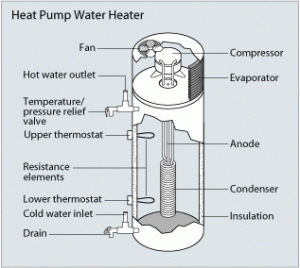Submitted by Energy Efficiency First

Electric water heaters used to be simple insulated tanks with a couple of electric-resistance elements that heated the water. As a U.S. Department of Energy (DOE) study put it, “Traditional Electric Resistance Water Heaters (ERWHs) are an inefficient and expensive form of water heating . . . and have the lowest source Coefficient of Performance and the highest cost per BTU of delivered water thermal energy.” The DOE posits that “swapping ERWHs with HPWHs could result in roughly 50% reduction in water heating energy consumption for 35.6% of all U.S. households.”
According to the DOE report, Heat Pump Water Heaters (HPWHs) promise to significantly reduce energy consumption for domestic hot water over standard ERWHs. While ERWHs perform with energy factors (EFs) around 0.9, new HPWHs boast EFs upwards of 2.0. With the advent of HPWHs, home owners get at least twice as much hot water from each kilowatt-hour of electricity consumed as from standard electric water heaters. The Energy Factors of these units range from 2.0 to 2.5–meaning that they are, effectively, 200% to 250% efficient at converting electricity into heat.
These efficiencies are achieved by combining a vapor compression system, which extracts heat from the surrounding air at high efficiencies, with electric resistance elements, which are able to help meet large hot water demands. The primary heating mechanism is a heat pump refrigeration cycle (like those in a refrigerator or air conditioner, but operating in reverse) that transfers heat from the surrounding air to the water stored in the tank. Auxiliary electric resistance elements are also included for reliability and quicker recovery. HPWHs are hybrids: they integrate a heat pump and electric resistance element(s) into a single storage tank. Puget Sound Energy (PSE) representatives have publically endorsed the fact that the AirGenerate AirTap unit will work efficiently down to 20 degrees, before it starts operating like a traditional resistance electric water heater.
DOE believes that HPWHs have efficiencies and operating costs similar to natural gas storage water heaters, making HPWHs an excellent choice for homeowners who currently use an electric resistance, fuel oil, or propane water heater and do not have access to natural gas. A caveat is that, if the unit would be installed in conditioned space, replacement of natural gas water heaters with HPWHs is not recommended in heating dominated climates because HPWHs will increase the load on the space heating system without a similar benefit to the space cooling system.
Instead of using electricity directly to heat water, a heat-pump water heater uses electricity to move heat from one place to another–in this case, from the surrounding air where the unit is located into the water. This is done by circulating a special “refrigerant” fluid that can be alternately evaporated into a gas and condensed into a liquid by changing its pressure. Surrounding air is drawn into the heat pump where the heat in that air vaporizes refrigerant in the “evaporator,” releasing cooler air into the room. The refrigerant vapor is then pumped through a “compressor” where it condenses back into liquid form and releases its stored heat into the water. All this sounds pretty complicated (and, well, it is), but this “refrigerant cycle” is well understood and widely used in both refrigerators and air conditioners.
How can a HPWH save you money if you have an existing electric water heater?
According to Puget Sound Energy, the average home uses 17% of its energy usage to heat water. This is the second largest way that a home consumes energy, after space heating.
DOE estimates that a HPWH will pay for itself in under five years.
The DOE table below, Table 4, shows the 2012 nationwide average cost to install a HPWH, after rebates are applied, as $2,100 and the predicted savings from operating a HPWH as $322. These calculations were based on average installation costs and average savings as indicated in the National Renewable Energy Laboratory’s (NREL’s) National Residential Efficiency Measures Database and the U.S. Energy Guide labels.
 Using these averages, DOE calculated the Simple Payback Period and the Return on Investment ratio for installing HPWHs. Two methods of evaluating the cost effectiveness of energy efficiency measures are simple payback (SPB) and return on investment (ROI). The SPB period is the ratio of incremental initial cost (dollars) to annual energy savings (dollars/year). The ROI is the ratio of net proceeds to the investment costs. DOE calculated SPB for HPWHs as 4.7 years, and the ROI as 113%.
Using these averages, DOE calculated the Simple Payback Period and the Return on Investment ratio for installing HPWHs. Two methods of evaluating the cost effectiveness of energy efficiency measures are simple payback (SPB) and return on investment (ROI). The SPB period is the ratio of incremental initial cost (dollars) to annual energy savings (dollars/year). The ROI is the ratio of net proceeds to the investment costs. DOE calculated SPB for HPWHs as 4.7 years, and the ROI as 113%.
While considerably more expensive to install than ERWHs, reductions in utility bills will likely result in more savings over the course of the water heater’s life. Also, because HPWHs provide such dramatic savings, rebates in the range of $1,800 are available to encourage utility customers to make the switch.
Call us to help find the right water heating solution for you. At Energy Efficiency First, in partnership with Quality Renovation and Carpentry, we couple construction experience with principles of building science, and we embrace emerging energy efficient technologies like the hybrid heat pump water heater. We also offer a complete set of energy performance contracting services.






















































